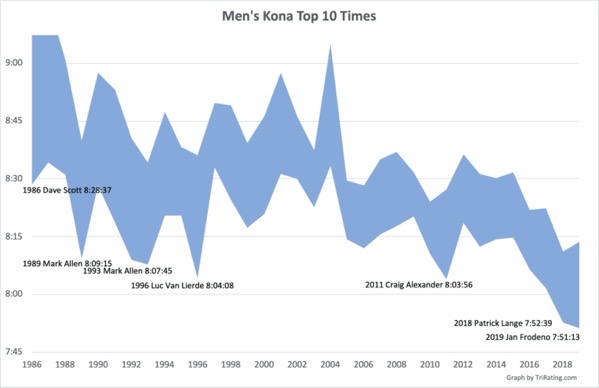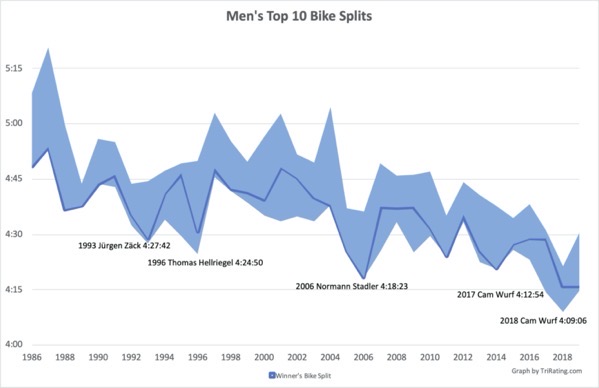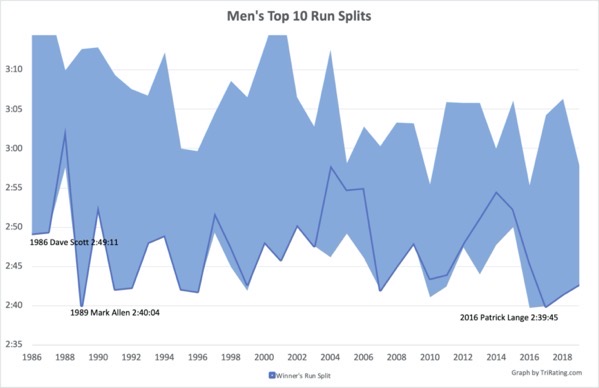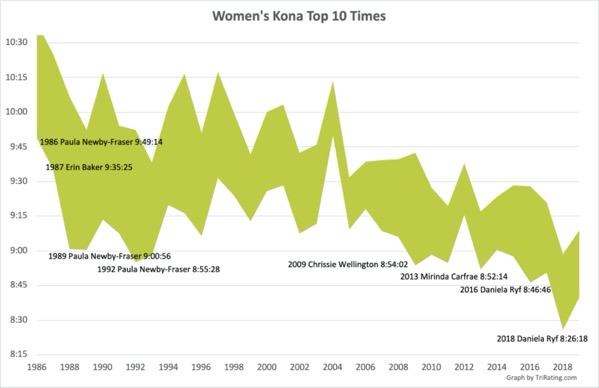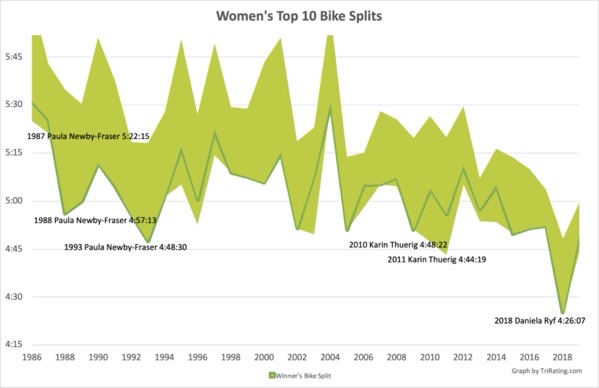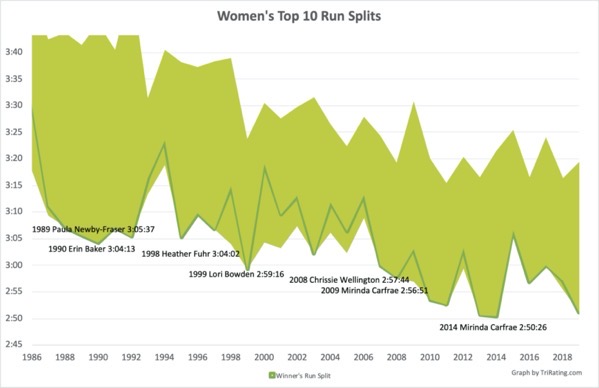This post looks at the times and splits at the Ironman World Championships in Kona, highlights some of the exceptional results and tries to spot some long-term trends.
The graphs were developed for Ironman as part of their coverage during what would have been race week. Greg Welch and I had a chat about it that was shown as part of their “Kona Celebration Week Daily Show 6 – E Ola Mau” (starting about 1:07 into the show) which you can still watch on the Ironman Now Facebook page. Many thanks to Greg and Julia for joining me on this awesome journey through Ironman history!
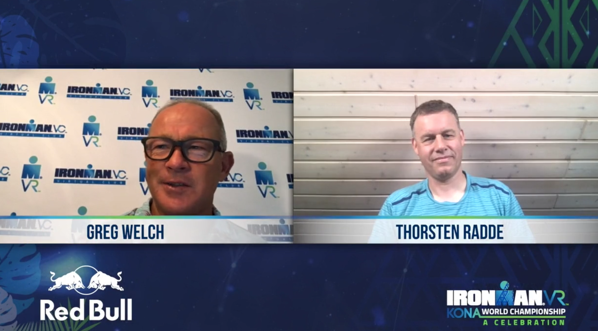
Overall Times
The first graph looks at the overall finishing times of the Top 10 in Kona, both for the men (blue) and women (green) from 1986 up to 2019:
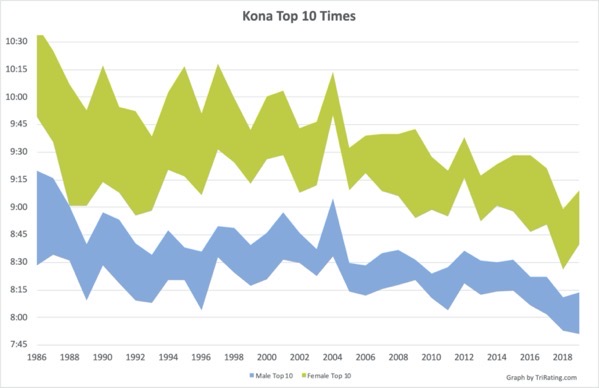
(For a hi-res version of this and all other graphs, just click on them.)
A few key points:
- There are a lot of “ups and downs” in the times – a sign of how variable the conditions in Kona are. It’s never a good idea to race Kona with a specific time goal in mind.
- 2004 has been a particularly slow year with a lot of wind on the bike. Normann Stadler rode by far the fastest bike split with a 4:37 – only two years later he rode a 4:18, setting a new bike course record. Both years he was winning the race!
- A recent example of a fast year is 2018 when bike and overall course records were set – conditions on the bike course were very fast with reportedly hardly any wind.
- The closest the women have come to the male finishers is still 1988 when Paula Newby-Fraser finished 11th overall.
Details for the Men’s Times
The next chart look at the men’s Top 10 and a couple of the course records:
You can distinguish between a few phases:
- Dave Scott brought down the course records in the first half of the 1980s down to sub-8:30.
- Then he and Mark Allen had their epic battle in 1989 (with a new course record of 8:09).
- Mark continued to race at that level, setting his last course record in 1993 and winning his sixth title in 1995. Luc Van Lierde set another CR in 1996.
- After that there was a period of “slower years” with winning times just under 8:30 for quite some time.
- Between 2005 and 2015 the winning times hovered around 8:15, with the notable exception of Craig Alexander’s course record in 2011.
- Since 2016 the winning times have come down, with two new course records in 2018 (Patrick Lange for the first time under 8 hours in Kona) and 2019.
- Jan Frodeno’s course record in 2019 is especially notable as a wider Top 10 indicates that the conditions were not that quick.
The swim plays an important tactical role but can be neglected for the overall finishing times. Let’s have a look at the bike and run splits to see where these faster times come from. First, the bike:
As before, the chart shows the bike times for the Top 10 men, with the winner’s bike time indicated by the darker blue line. Again, most of the course records are indicated.
- It’s clear that the winner almost always had the fastest bike leg or is at least quite close to the fastest split. There are very few exceptions such as 2007 or 2017 when the race was won by strong runners (Chris McCormack and Patrick Lange).
- The bike times have been getting faster in “steps”: In the 1990s (just under 4:30) and mid-2000s (just under 4:20) by German “Uber Bikers” (Jürgen Zack, Thomas Hellriegel, Normann Stadler) and then again after 2016 with Cam Wurf setting two new bike course records in 2017 and 2018 (now just under 4:10).
- Similarly, the bike times within the Top 10 have come down – sub-4:30 is roughly what is needed these days.
The next graph has a closer look at the Men’s Run Splits:
- Maybe even more than for the bike leg, the winners are very close to the fastest run time among the Top 10. There are only a few exceptions, for example Normann Stadler in 2004 and 2006 or Sebastian Kienle in 2014.
- Overall, the run times have not come down since Mark Allen’s 1989 course record. Even if Patrick Lange has set a new course record in 2016, he and Dave Scott are still the second and third fastest runners in Kona history!
- The same applies for the rest of the front finishers, you can still finish in the Top 10 with a 3-hour marathon.
Details for the Women’s Times
Of course the look at the women’s finishing times is also interesting:
There are some interesting data points:
- Paula Newby Fraser has been the athlete bringing finishing times by quite a lot: Her first course record was a 9:49 in 1986 – she brought that down to just over 9 hours in 1989.
- Erin Baker was able to break Paula’s record in 1987, but Paula took it back just one year later.
- Paula’s fastest time in Kona was 8:55 in 1992.
- After that, times were a bit slower until Chrissie Wellington took the course record with an 8:54 in 2009, followed by Mirinda Carfrae with an 8:52 in 2013.
- Daniela Ryf set two new course records in 2016 and 2018, bringing the current record down to sub 8:30!
- Chrissie, Rinny and Daniela have also increased the pressure on the rest of the women, resulting in the Top10 times coming down from about 9:45 in the early 2000s to under 9:15 in recent years.
Here’s a look at the women’s bike splits:
- As for the men, the winner consistently posts one of the fastest bike splits
- It’s again Paula Newby-Fraser who brought the bike records down from 5:22 in 1987 to 4:48 in 1993.
- It took Karin Thuerig, a world-class athlete even among the time trial specialists, to set new course records in 2010 and 2011.
- That time wasn’t broken before 2018, when Daniela Ryf leveraged the perfect conditions to lower the record to 4:26.
- As for the overall times and the men’s bike times, the female bike times for the Top 10 have come down since about 2012.
Here’s the last graph – a look at the female run times:
- This graph shows the same message as before: The winner is almost always within a minute of the fastest split. This is true even for Daniela who isn’t really known as a speedy runner!
- There’s been some improvement in the run times in the years of Paula, Erin, and Heather Fuhr (all of them about 3:04), then a bigger step down to Lori Bowden’s first sub-3 marathon in Kona in 1999.
- Chrissie and Rinny brought these times down to just over 2:50.
- Until Anne Haug in 2019, the run times have been a bit slower than that.
- The Top10 run times haven’t changed much in the 2000s, it’s still possible to finish in the Top10 with a run split over 3:15.
Expectations for the Future
Are there any trends we can look for in the next few years? Here are a few speculations:
- We’ve seen a lot of improvement on the bike, but maybe there’s still some potential left for the top women.
- On the marathon, I think that there will be some faster times needed for a Top 10 finish, potentially aided by more even bike rides, better nutrition or heat adaption and maybe new, faster shoes.
- For a Top 10 finish, I expect the men will need a run under 2:50 and for the women under 3:10.
- Any overall improvements will likely come from a close race where two or more athletes are battling for the win. On the men’s side, it might be a front bike group that forces Frodo to bike and run hard, and on the female side I don’t think that we’ve seen Daniela running to her full potential quite yet.
Where do you think we will see improvements in the next years?
